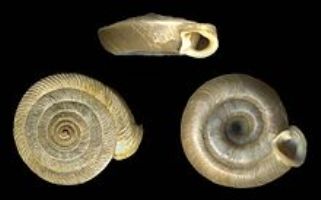
Classification
The Millerelix simpsoni species can be found in this scientific classification below. Reference ZipcodeZoo for more in depth classification details.
Domain: Eukaryota
Species: Millerelix simpsoni
Millerelix simpsoni like many other organisms in the world, are complex. Scientists are able to better understand each organism by looking at a phylogenetic tree (Gillis, 2012). Classification in the simplest form consists of a domain, kingdom, phylum, class, order, family, genus, and species classification (Gillis, 2012). Although most phylogenic trees are more complicated because they can have groups within each grouping. Continuing on, an organism will be placed onto a specific domain, kingdom, phylum, class, order, family, genus or species if it has a homologous characteristic of the said group (Gillis, 2012). A homologous characteristic is a physical characteristic that has the same common ancestor (Gillis, 2012). In other words, the organism in a specific group came from an ancestor and all the organisms in that group also had the same ancestor (Gillis, 2012). Phylogenetic trees are like pyramids. In general, the pyramid starts off large with millions of diverse organisms. This is called the domain classification. Then as the organism moves towards the top, the organisms become more similar until finally they are all the same.
As for Millerelix simpsoni, it is first seen in the domain
Eukarya. It is seen in this
group because it is a eukaryote cell.
Eukaryote cells have organelles such as:
the cell membrane, cytoplasm, nucleus,
golgi apparatus, mitochondria, rough
endoplasmic reticulum and smooth
endoplasmic reticulum (San Dieco State
University. 2012).
Following the domain, this species is next found in the kingdom,
Animalia. Animalia characteristics are
multi-cellular and heterotrophs (Animal
Diversity Web, 2012). Heterotrophs
cannot get their energy from sunlight
and must receive their energy from other
organisms (Hickman et al. 2012). In
addition, these organisms have tissues,
no cell walls, and they can digest their
food (Animal Diversity Web 2012).
Moving up in the pyramid is a phylum. Millerelix simpsoni
is found in phylum Mollusca. Mollusca
have a head, visceral mass and a foot
(Gillis, 2012). Visceral mass in a snail
is essentially the body of the snail
that contains all of its internal organs
(Hickman et al. 2012). The foot is
primarily used for locomotion and
capturing food (Gillis, 2012). To
enclose the various organs, molluscs
have a mantle (Gillis, 2012). In
addition, this phylum also developed a
radula (Gillis, 2012). A radula is an
organ that is used to remove the outer
portion of the snail’s food, which can also be learned about on the
nutrition page (Gillis, 2012).
Next grouping category is called a class, in which it is found in
class
Gastropoda. All gastropods have a shell that is highly coiled, a
soft body, a foot, torsion, one to two
tentacles, and eyes (Leonard, 1959).
Torsion occurs when the visceral mass
becomes twisted during the snail
development (Gillis, 2012).
Additionally, gastropods can be
monoecious (contains both female and
male sex organs) or dioecious (either
female or male sex organs) (Hickman et
al. 2012).
Millerelix simpsoni are
monoecious (Thorp and Covich, 2010).
Continuing onto the order, Millerelix simpsoni
is classified in the order
Pulmonata. Organisms in this order
include both terrestrial and aquatic
snails and even some slugs (Hickman et
al. 2012). A key physical characteristic
for this group is that most organisms
have developed a lung used breathing air
(Hickman et al. 1959). Additionally
within the order Pulmonata there are two
suborders: Basommatophora and
Stylommatophora (Hickman et al. 1959).
Millerelix simpsoni is in the
suborder, Stylommatophora because its
eyes are located on top of its tentacles
(Leonard, 1959). In contrast, organisms
in the Basommatophora have eyes on the
bottom or base of its tentacles
(Leonard, 1959).
The next group that adds more specific characteristics about
Millerelix simpsoni
is a family. This snail’s family
is the Polygyridae (Leonard, 1959). Polygyrids have shells that appear to be lens
shaped and the opening of the snail’s
shell is a dull, white, glossy color
(Leonard, 1959). Lastly, the snail can
be further placed into its genus named
Millerelix.
In this genus, organisms will have an
umbilicus (Leonard, 1959).
Return to Homepage